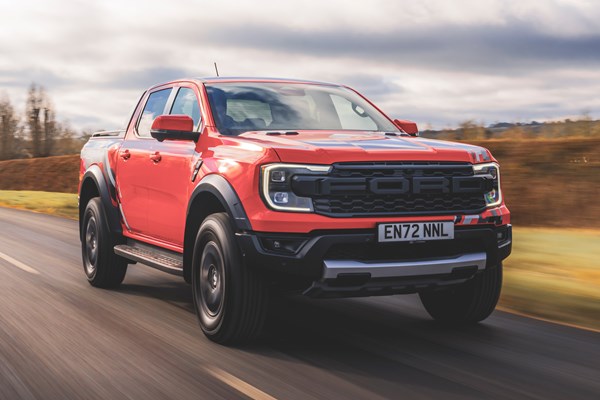Ford Ranger Raptor review (2025): the most exciting off-road pickup on sale in the UK
The closest we’ll ever get to living the US truck lifestyle in the UK
PROS
- Quick and fun to drive
- Comfortable ride on-road
- Amazingly capable off-road
- Plenty of equipment
- Punchy V6 engine
CONS
- Low payload for a pickup…
- … so, you can’t claim the VAT back
- Expensive to buy and run
- Diesel engine is unchanged
Summary
The Ford Ranger Raptor is a high-performance pickup truck, optimised for high-speed off-road driving but remarkably capable on tarmac as well. As such, while the standard Ford Ranger is unquestionably one of the best pickup trucks you can buy - in fact it's the 2025 Parkers Pickup of The Year - the Ranger Raptor is a much more indulgent choice. Pricey to buy, pricey to run, it's aimed at people who want a pickup rather than those who need one. But we reckon it's all the better for it, as it solves some of the issues we had with the first-generation Ranger Raptor making it even more fun and entertaining.
Ford has doubled-down on the second-generation Raptor Raptor by fitting it with a powerful V6 petrol engine in place of the previous rather ordinary diesel motor, adding a host of completely over-the-top suspension upgrades, and boosting luxurious levels in the cabin. Now, it’s closer than ever to a trophy truck when you’re driving off-road, but it also improves on the previous model’s famed comfort levels when you return to civilisation.
Don’t be fooled by its appearance, though. The Raptor is not a workhorse. That fancy off-road suspension severely limits its carrying capacity and that posh leather-lined interior wasn’t designed to spend its life covered in cement dust and paint. This is an aspirational vehicle designed for lifestyle buyers who don’t mind attracting attention wherever they go. And we can’t help but love it.
What’s different between the Ranger Raptor and the standard Ford Ranger?
Quite a lot. The Raptor’s overall shape might look like a standard Ranger, but that’s about where the similarities end. It’s been enhanced in almost every direction.
Styling tweaks include tough steel bumpers, a stronger metal bash plate and a new bonnet with functional air vents and a power bulge (like a muscle car). The Raptor’s front and rear wings are wider, too; there’s a larger (and louder) exhaust system and, perhaps most strikingly, it gets a new radiator grille with enormous ‘Ford’ lettering like the US-market Ford F-150 pickup.
But Ford’s upgrades are much more than just cosmetic. The Raptor’s 292hp 3.0-litre V6 petrol engine is unique to the model – and it really sets the truck apart from the more sensible diesel powertrains offered in the Ranger. It gives the Raptor an impressive turn of speed, and its valved exhaust system allows it to bark and whistle like a rally car.
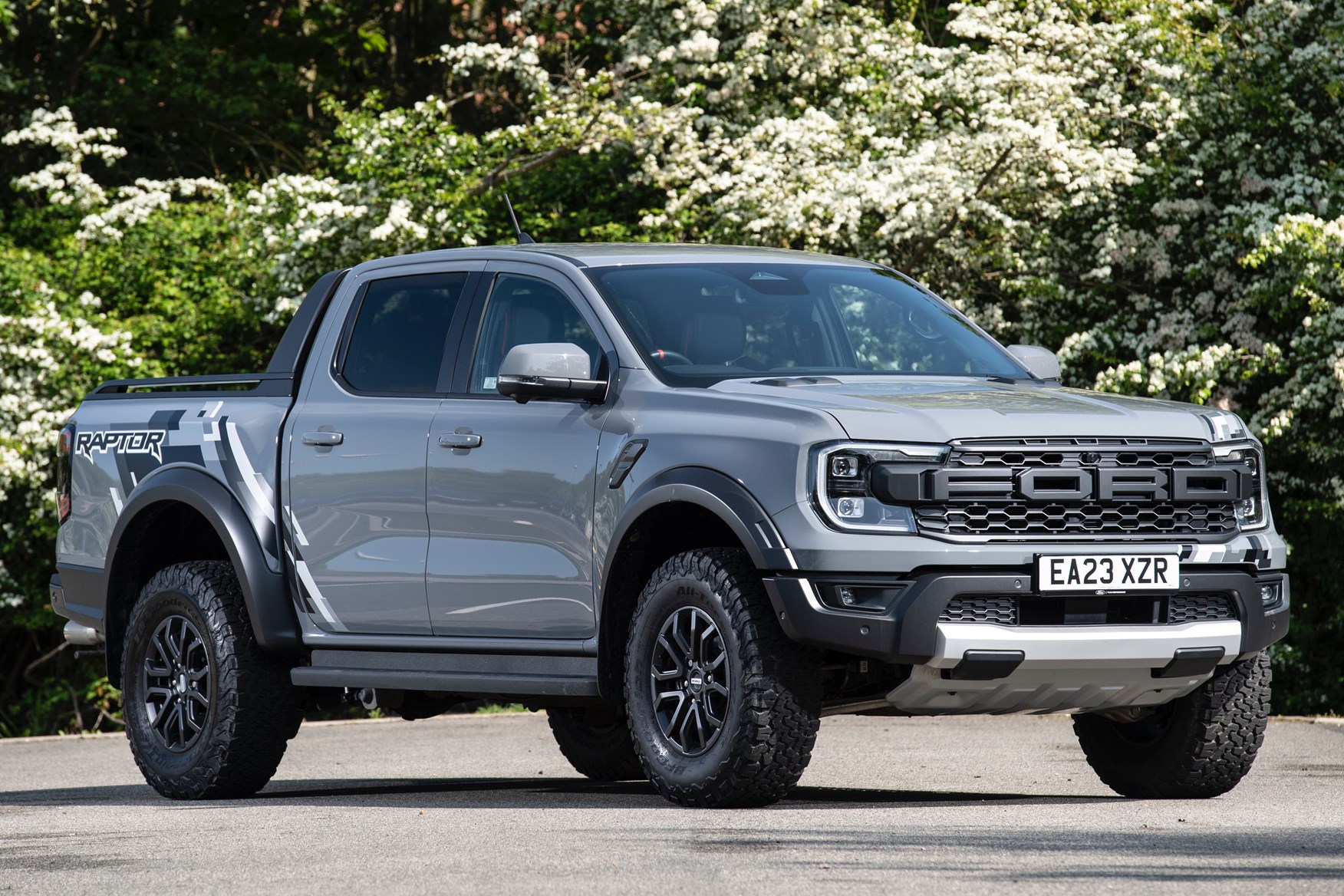
Then there’s the suspension, which has been completely redesigned for the Raptor. It’s unlike anything else fitted to a factory-delivered road-going pickup. The headline feature is a set of trick FOX adaptive dampers that can be configured for everything from popping down to the shops to flying over off-road jumps.Those that want to retain a modicum of sensibility can still opt for a diesel, too, as Ford elected to retain the old Raptor’s 205hp 2.0-litre Bi-Turbo unit. Be warned, though – the diesel does without a lot of the off-road equipment that makes the Raptor so much fun. Just let your inner child win the argument and buy the petrol. There really isn’t anything else like it on the market and, with the 2030 ban on combustion engines looming large, the V6 Raptor could be the last of its kind.
Verdict: is the Ford Ranger Raptor any good?
Yes. It’s utterly brilliant. It’s a pickup truck that can sprint from 0–62mph in 7.9 seconds and tackle harsh terrain with the same competency as a Dakar racer. But, put it on a sealed tarmac road and it’ll keep you as comfortable as a family SUV.
Does anyone actively need one? Not really – but you can level the same argument at sports cars that are capable of speeds you’ll never be able to reach on public roads. There are more work-hardened pickup trucks than the Raptor, but there are none that will make you grin quite as much.
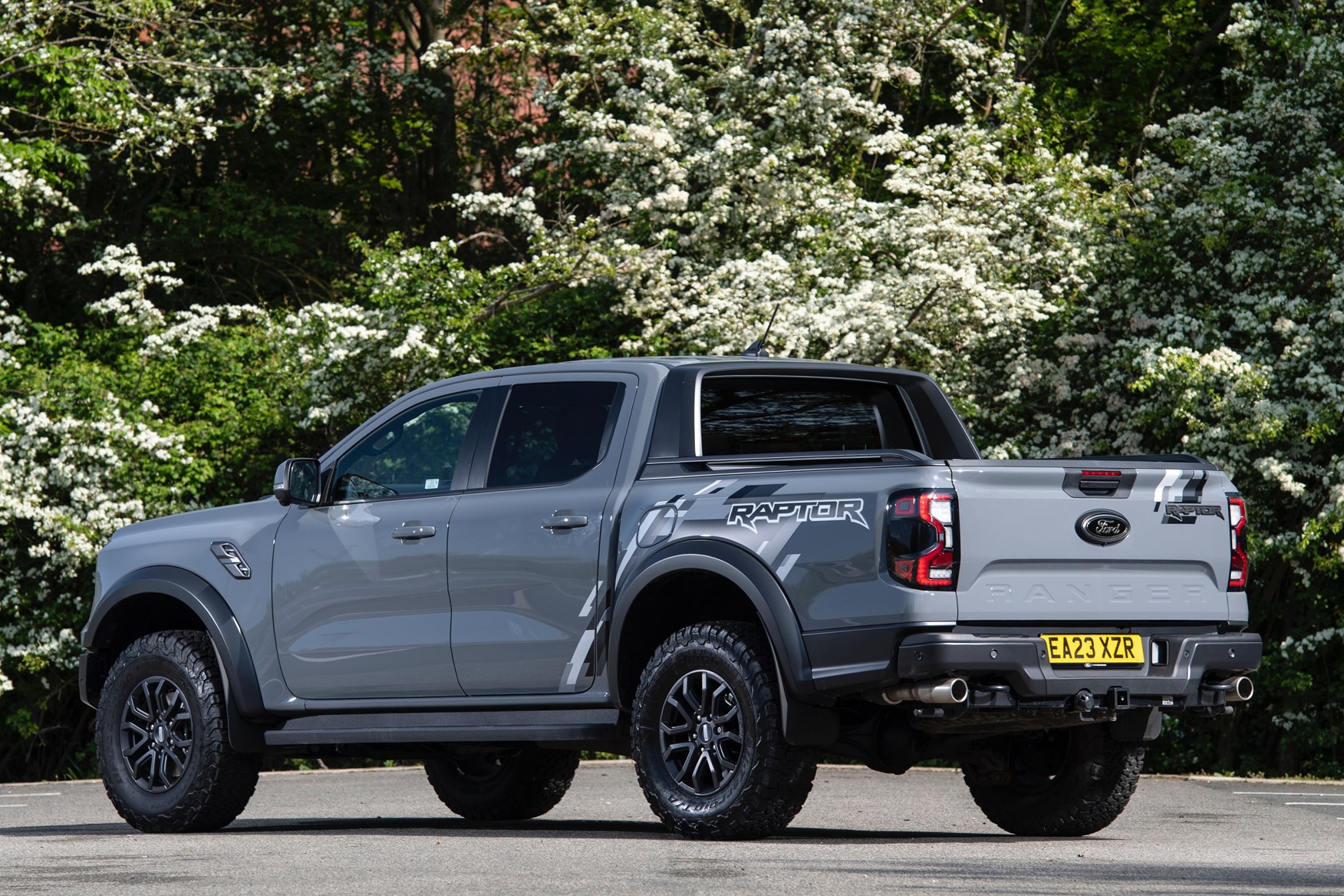 The only sticking point is the price. The diesel starts from £56,500, while the V6 petrol is priced from £58,900. Our test vehicle, which came with a few choice options, cost almost £62,000 – and that’s an awful lot of money to spend on an off-road toy. What’s more, if you’re buying it for business use, its 652kg payload means you can’t claim the VAT back from the government.
The only sticking point is the price. The diesel starts from £56,500, while the V6 petrol is priced from £58,900. Our test vehicle, which came with a few choice options, cost almost £62,000 – and that’s an awful lot of money to spend on an off-road toy. What’s more, if you’re buying it for business use, its 652kg payload means you can’t claim the VAT back from the government.
But, even if it can’t carry the full 1,000kg required to be officially classed a commercial vehicle, the Raptor is hardly impractical. Its load bed is large enough to carry a shipping pallet, it can tow 2.5 tonnes and there’s enough space in the cabin for four adults. Pair these traits with its unstoppable off-road ability and it might just be the ultimate vehicle for active families.
Skip to our full verdict on...
- Unflappable off-road ability
- Impressively comfortable on tarmac
- Fast – but it could have been faster
It's obvious the Ranger Raptor is brilliant off-road, so we’ll start with how it performs on tarmac. That clever rally-bred suspension is massively over-engineered for the sorts of lumps and bumps you’ll find on the road – and that means it soaks up most imperfections with competent ease, even at motorway speeds.
The Raptor’s ride quality is more sophisticated than its pickup truck rivals, too. The dampers keep the body stable on an undulating back road, and the chassis doesn’t jitter like a SsangYong Musso or Isuzu D-Max. That makes it an easy truck to cover miles in. It's not quite as comfortable as the best SUVs out there, sharp bumps sometimes reminding you of the heavy live axle, but it's exceptionally good for a truck.
It handles neatly, too, which is impressive considering its size and bulk. Like all Fords, the Raptor’s steering is direct and well-weighted, giving you a confidence-inspiring feel of connectedness to the front tyres. It’s easily the most engaging pickup truck on the market to drive – and you’ll be hard-pressed to find an equivalent SUV that offers the same number of smiles-per-mile, especially if you head off-road.
Many different driving modes
There are so many driving modes on the Ford Ranger Raptor that we barely seemed to scratch the surface of its capability. There are seven modes to choose from, three of which are designed for road use and four that are reserved for more challenging surfaces. On top of that, there are three buttons on the steering wheel that allow you to adjust the volume of the exhaust, the stiffness of the suspension and the level of steering assistance.
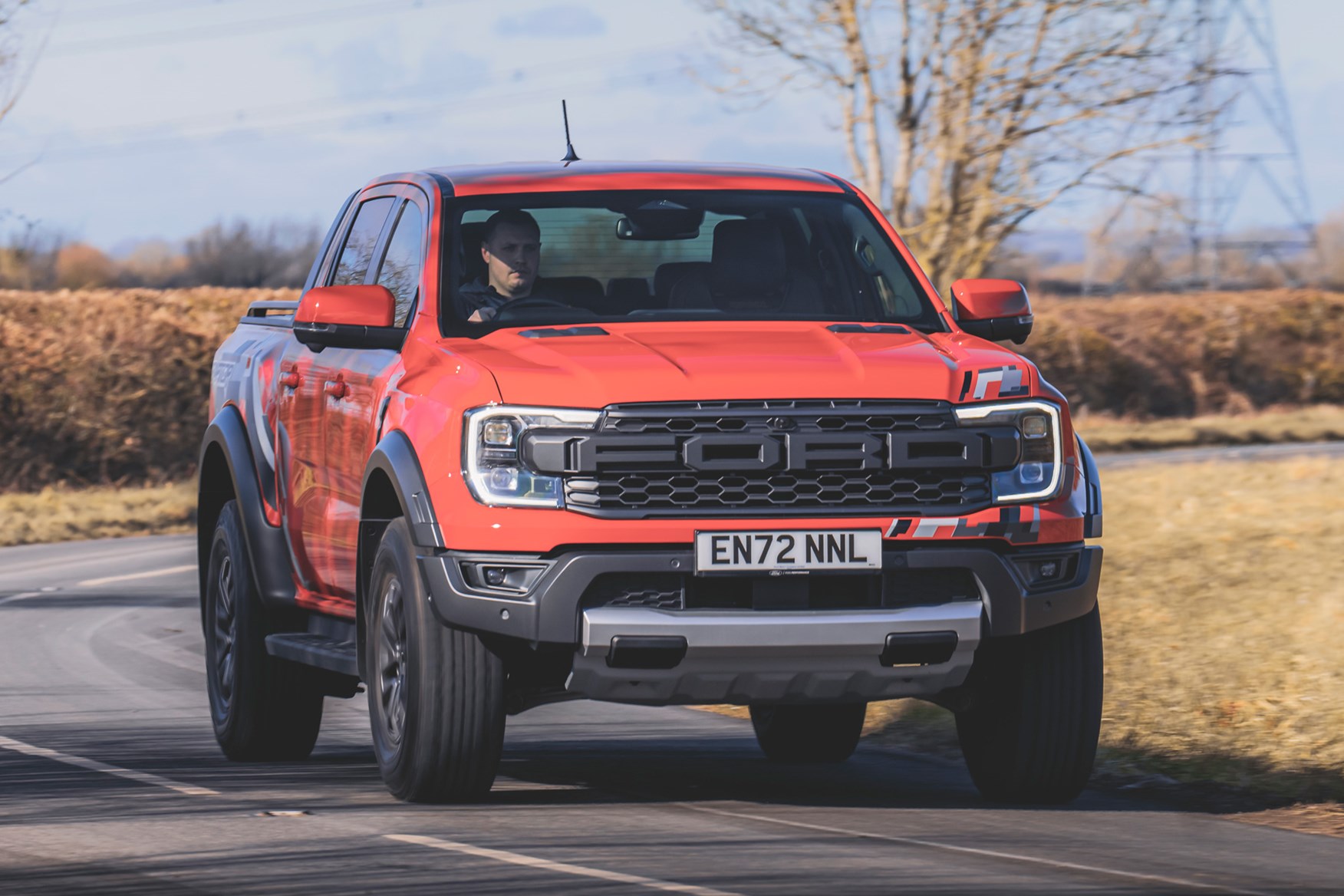
The road-biased modes are called Normal, Sport and Slippery, while the bush-bashing options are Rock Crawl, Sand, Mud/Ruts and the maximum attack Baja mode – but more on that in a moment. Each setting tweaks the throttle response, suspension stiffness, steering assistance, traction control intervention and four-wheel drive system to maximise progress over each surface.
Unless you do a lot of off-roading, you’ll spend most of your time in Normal mode. Switching to Sport doesn’t drastically impact performance, although it does give you a greater sensation of speed thanks to heavier steering, snappier throttle and louder exhaust note. The main advantage is a slightly stiffer damper setting which helps agility a little on road.
Sadly, there’s no all-out on-road drive mode, mostly because tarmac isn’t the Raptor’s preferred home. The UK Raptor also isn’t as quick as it could be – and you can tell its engine has more to give. Australian-delivered versions of the pickup produce 392hp and 583Nm of torque but, for some reason, Ford decided to choke this output for the UK market.
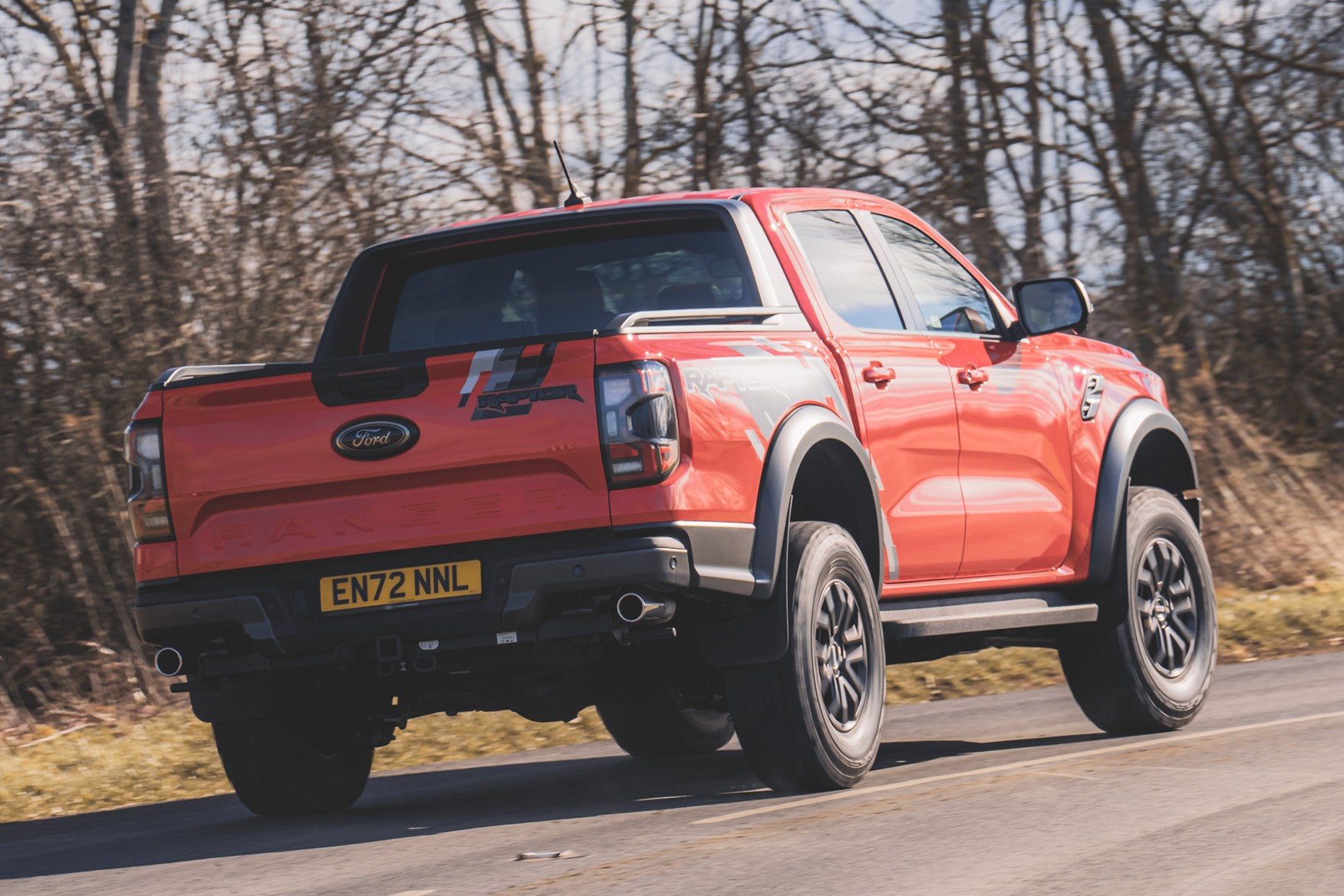
Don’t get us wrong, the Raptor is still mightily quick for a pickup truck, but we’ve seen faster. The V6 diesel engine in the old Mercedes X-Class was almost half a second quicker to 62mph. It’s a shame but, if you’re desperate for some extra power (and don’t mind voiding your warranty), the aftermarket scene has already cracked the Raptor’s ECU. However, we'd point out that on the knobbly off-road tyres, even the standard V6 output is enough to get the rear wheels spinning with ease in 2WD mode.
What’s the Ford Ranger Raptor like off-road?
The Raptor is in its element off-road. Its driving modes, suspension and four-wheel drive system offer a solution to tackle almost any terrain. Stuck in a bog? Simply stick the chassis in Mud mode, engage low range and watch the Raptor pull itself free. Driving down a rocky slope? Rock Crawl mode and hill descent control will stop the truck running away from you.
Want some thrills? Put the truck in Baja mode then manually force it to run in rear-wheel drive. Baja mode sharpens the throttle response, tunes the adaptive suspension to better tackle bumps and forces all the valves in the exhaust wide open. And that allows you to rocket down off-road trails with reckless abandon, probably going quite sideways.
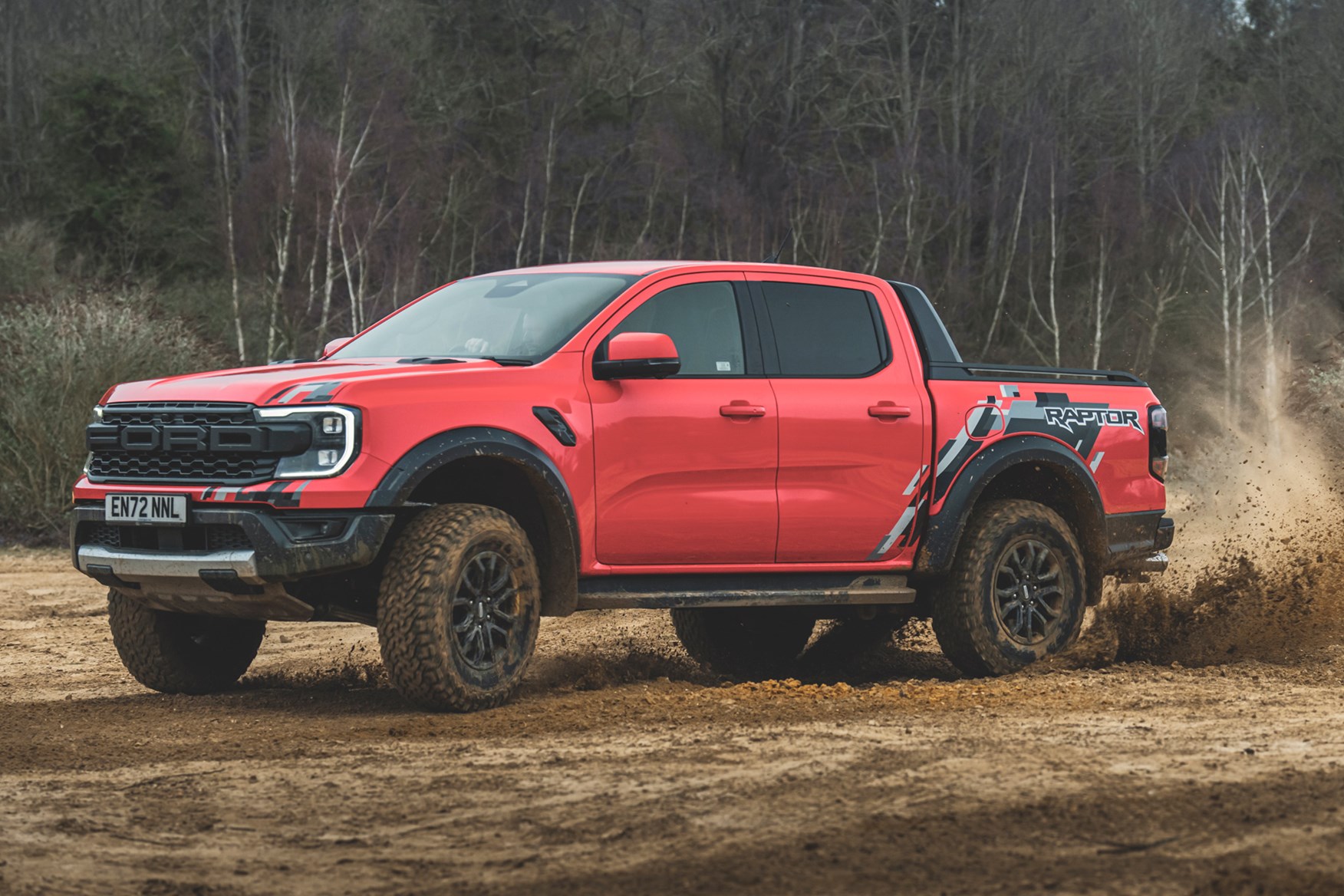
Ford designed an off-road circuit for the UK launch event – and we found that the faster we drove over the surface, the smoother the ride became. We’re talking motorway speeds through a forest clearing, here, and the Raptor didn’t even bat an eye. Even the most extreme versions of the Toyota Hilux and Isuzu D-Max would have fallen apart if asked to do the same.
The European launch event also had a jump that allowed us to get all four of the Raptor’s wheels off the ground. We were dumbfounded by how well it took this in its stride – there was no jolting on landing and no squirming around as it readjusted to being back on the ground.
Pickups with conventional leaf-spring suspension would react very differently in this situation to say the least. The speed at which the Raptor’s wheels go up and down, and how smooth the cabin stays during such punishment is a wonder to behold.
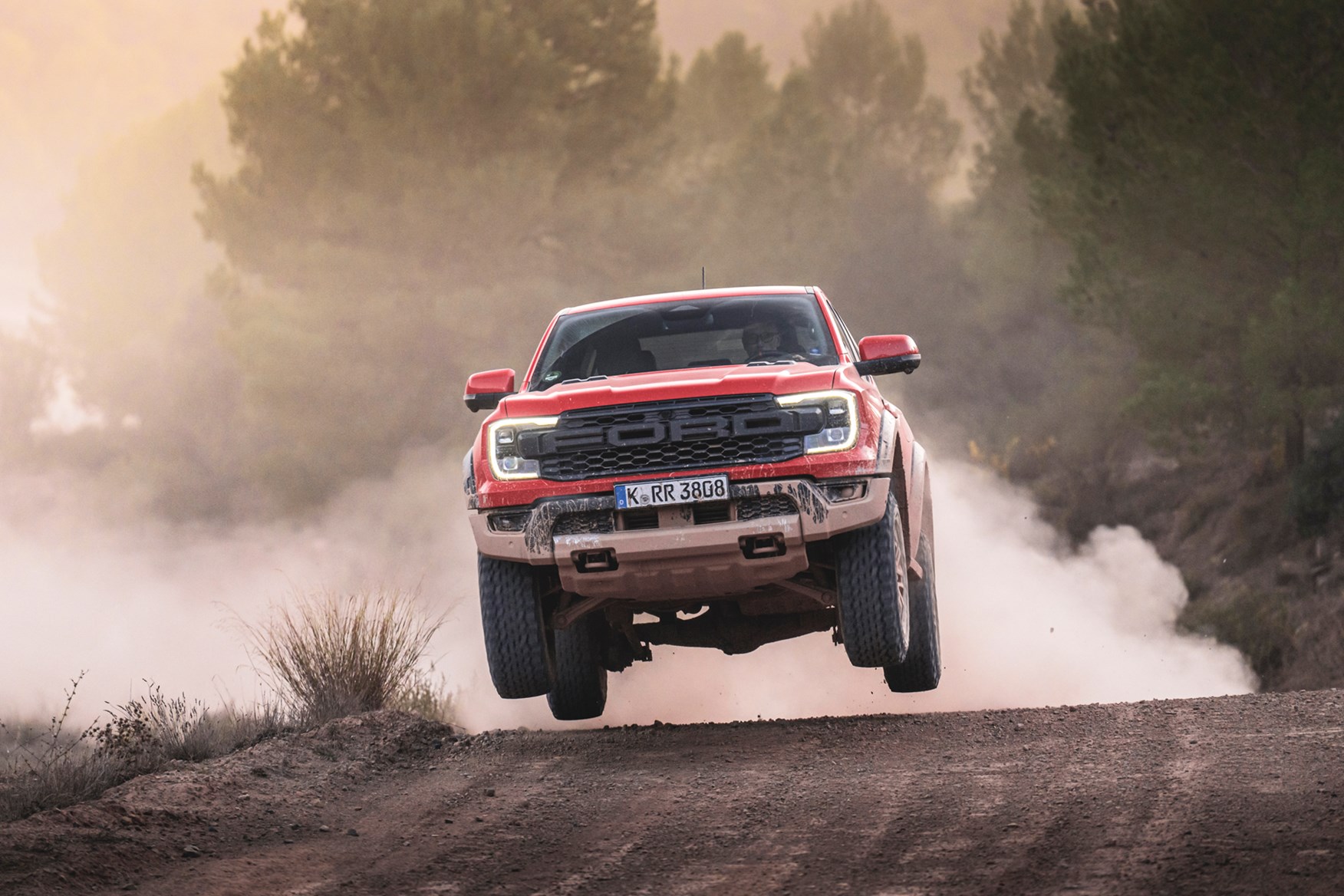
In both events, we also got the chance to try out the Raptor’s anti-lag system, which is activated when the truck is in Baja mode. It’s a system that keeps the turbos spinning when you lift off the throttle. The upshot? No lag – so you have plenty of power on tap when you mash the throttle on the other side of the corner.
The Raptor isn’t completely infallible off-road, though. It’s a big, heavy vehicle which means it won’t fit through gaps cars like the Suzuki Jimny or Dacia Duster can squeeze through. And while those huge all-terrain tyres will get you over almost anything, they don’t stop you from getting stuck if you’re not paying attention.
We got into a spot of bother in some loose sand while travelling up a steep hill. We’d lost momentum while fiddling with a function that allows you to set a crawl speed (2mph in our case), take your feet off the pedals and let the truck do the work.
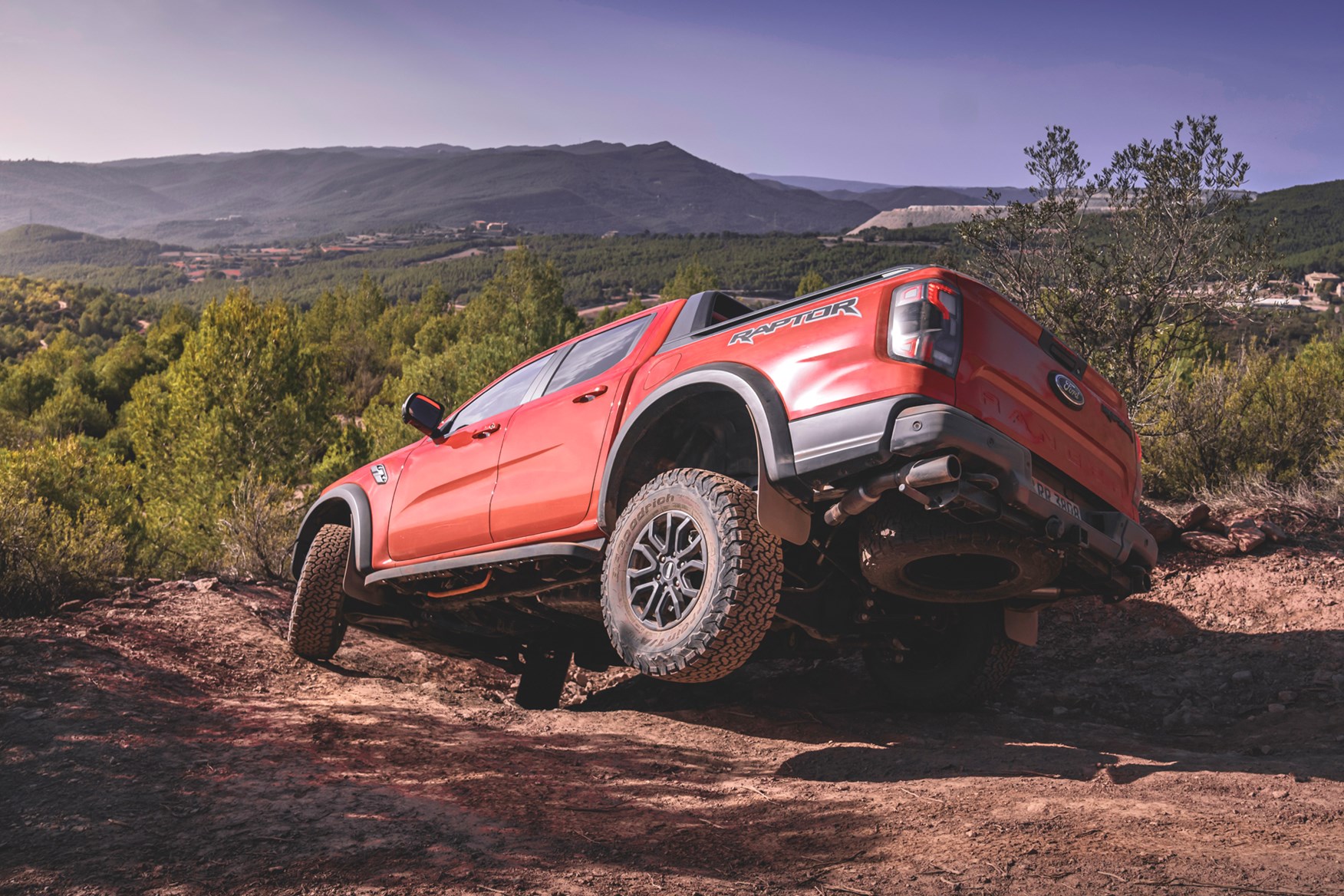
The Raptor bogged into the sand and, had we hammered on the throttle to try and free it, it would have dug itself further into the surface and stranded us. However, some intelligent use of the locking differentials, a little reversing and some careful line choosing resolved the problem.
- Loads of equipment for a truck
- Plenty of customisation options
- Great infotainment system
The Ranger Raptor’s cabin has a very utilitarian layout, but it’s packed with luxury materials and fancy technology that elevate it beyond its commercial vehicle origins. The seats, for example, are electrically adjustable, heated and trimmed in leather upholstery. They’d look at home in a premium SUV, never mind a rough-and-tumble pickup truck.
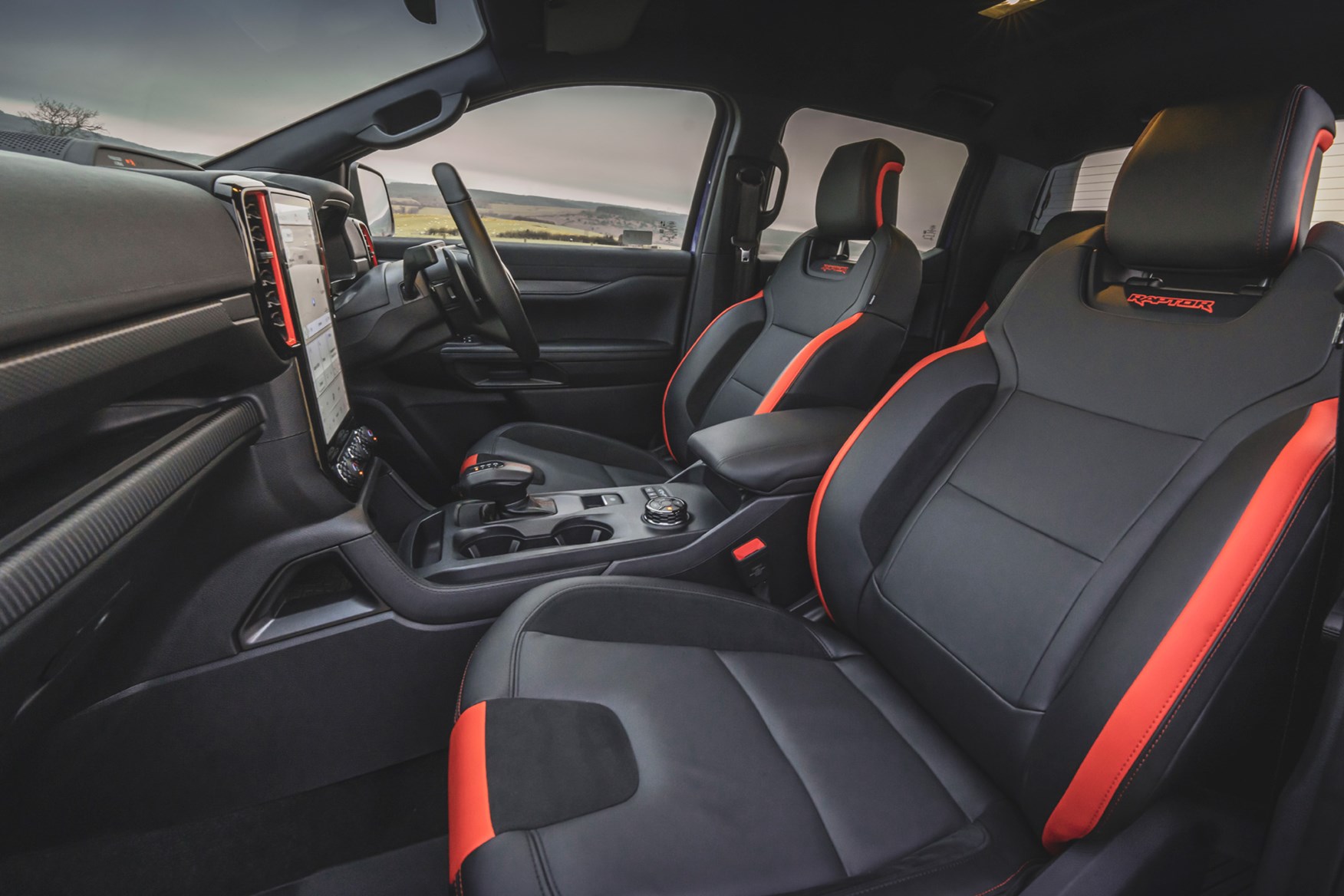
The dashboard and door cards are also trimmed in plush soft-touch materials and the cabin is littered with coloured accents that match the exterior paintwork. It’s certainly more refined than the standard Ranger and the interior seems to have been screwed together with more care. But then it should be, considering the price.
Infotainment and technology
The dashboard is dominated by an enormous 12-inch portrait infotainment system which runs on the same Sync 4A software as the Mustang Mach-E electric SUV. Most of the cabin functions have been moved onto the screen but, thankfully, Ford has retained a traditional rotary dial for the volume knob and some physical buttons for the climate control system.
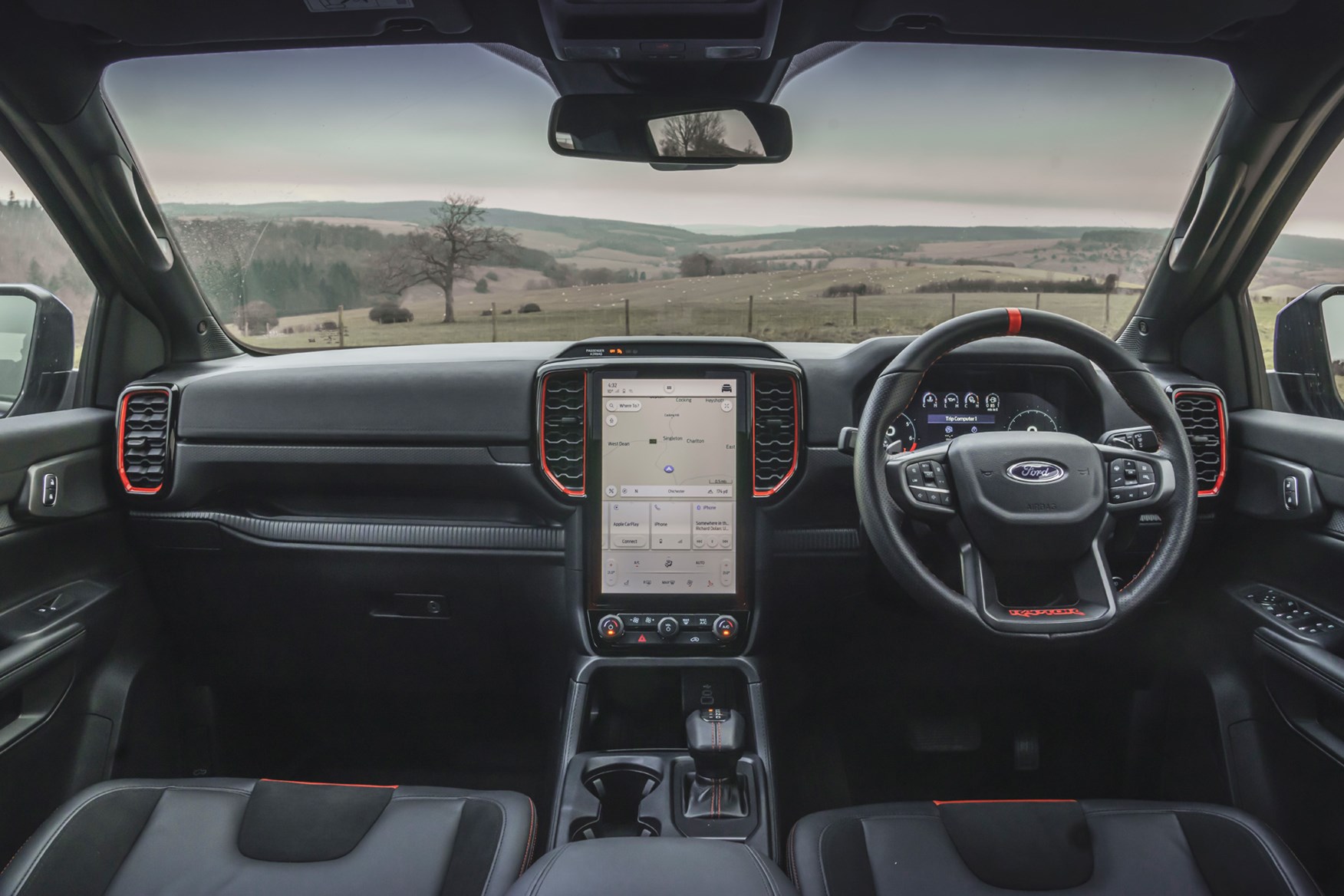
There’s also a small cubby below the central screen where you can wirelessly charge your phone, while Apple Carplay and Android Auto are both wireless. The Raptor also comes with a powerful 10-speaker Bang & Olufsen stereo system as standard, which massages the tedium of a long road trip.
Noise and refinement
The Raptor’s V6 sounds great, but legislation has stifled its roar. New cars need to comply with strict sound emission regulations so, even in Baja mode, the exhaust note is tasteful rather than raucous.
But changes like this allow the Raptor to match most family SUVs for comfort and refinement. The biggest indication of its commercial vehicle roots were those big all-terrain tyres. They produce a bit of rumble at speed, but the insulation from the windows muffles most of that well.
- Expensive to buy
- Thirsty V6 petrol, diesel not much better
- Doesn’t qualify for lower van company tax rates
The Ranger Raptor is not a cheap vehicle to buy. With a list price of around £57,000, you pay a hefty premium compared to its similarly sized rivals. However, this is only part of the story.
Ford Ranger Raptor tax
Because of its weight and associated payload, the Raptor doesn’t meet the criteria to be classed as a light commercial vehicle. That means you can’t claim the VAT back from its purchase price – and that automatically makes it far more expensive than any other pickup to buy.
The Raptor has a gross vehicle weight of 3,130kg and a payload of just 652kg. To be classed as a van for tax purposes it would need to have a payload of at least 1,000kg – and achieving that figure would have required compromises to the truck’s suspension setup that Ford wasn’t willing to consider. Altering the chassis for load carrying would have negatively impacted its off-road performance.
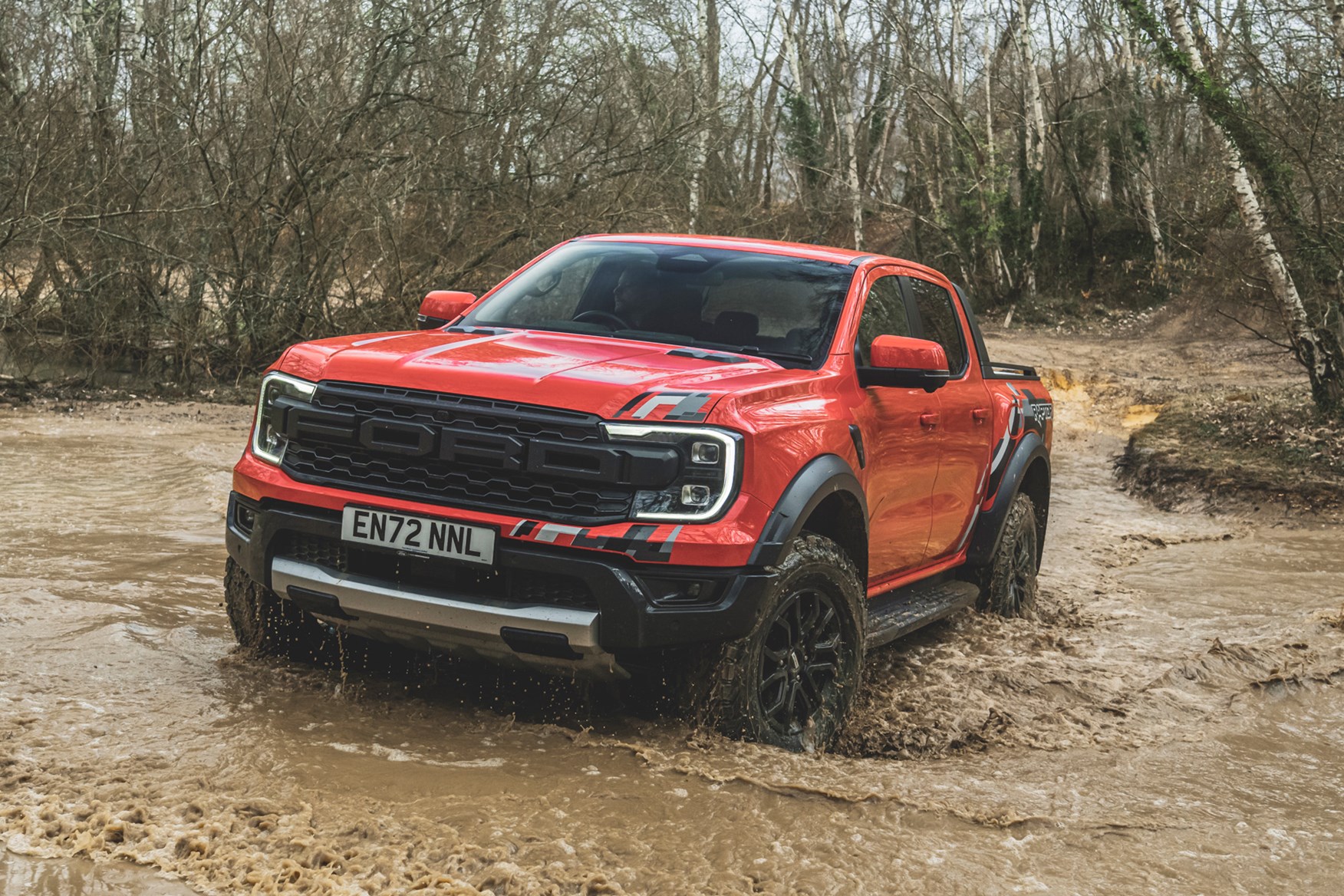
It’s not all bad news, though. It is classified as a light commercial vehicle for VED and company car taxation purposes, which means it qualifies for slightly lower rates on those fronts. However, this does mean it must adhere to the lower van speed limits on the road.
Ford Ranger Raptor MPG
The Raptor’s fuel economy is about as good as you can expect from a heavy, tall pickup truck riding on all-terrain tyres. In official WLTP tests, the V6 model managed an official rating of 20.4mpg. The diesel’s figures are slightly better, coming in at 26.6mpg. This is slightly disappointing given the official rating for the previous diesel model was 31.7mpg.
After a day of on- and off-road testing in a V6 Raptor, its trip computer said we’d averaged around 15mpg – but to be fair, that test had involved a high-octane thrash around an off-road track. When driven with a little more care, you'll get figures approaching the 20s..
Ford Ranger Raptor servicing
Service intervals for the Ford Ranger Raptor are set at two years. However, Ford expects you to only cover 12,500 miles in that time, meaning many drivers will find themselves heading to the dealership for a service before the 24-month mark rolls around. But keeping on top of maintenance isn’t a bad thing if you use the truck’s off-road capability on a regular basis.
Ford Ranger Raptor warranty
The Ranger gets the same warranty as the rest of the Ranger line-up, with three years and 60,000-miles of cover. This is about standard for the class, although it falls a long way short of the 10-year cover offered by Toyota for its Hilux.
Ford Ranger Raptor standard equipment
The Raptor is a standalone specification in the Ranger line-up, which means there’s only one version on offer. It comes spectacularly well-equipped, though, with the following highlights:
- Front and rear Fox Racing 2.5-inch live-valve shock absorbers (petrol) Fox position sensitive dampers (diesel)
- Rear coil spring suspension (instead of leaf springs) with a Watt’s linkage to limit horizontal movement
- Modified, strengthened chassis frame, particularly around shock absorber towers
- New aluminium upper and lower suspension arms
- All-round, larger disc brakes
- Locking differential (rear only on the diesel, front and rear on the petrol)
- Anti-lag mode (petrol only)
- All-terrain tyres
- Model-specific, larger front bash plate
- Unique front and rear bumpers with towing hooks
- Heated, powered front sports seats
- Heated leather steering wheel with centre marker and magnesium paddle shifters
- Seven selectable driving modes (damper tuning for the suspension only available on the petrol, along with jump mode and launch mode)
- Active exhaust system with four different modes to suit different driving scenarios (petrol only)
- 12-inch touchscreen with Sync 4A system
- 10-speaker B&O sound system
- Wireless Apple CarPlay and Android Auto
- Wireless phone charging
It also has a series of switches in the cabin that can be connected to any auxiliary accessories needing power that you choose to attach.
There aren’t many options that you can add to such a well-specified vehicle. Most of them are visual tweaks like metallic paint, exterior decals and a pack with a roll-over bar and a roll-top tonneau cover.
The Ford Ranger Raptor is a long-standing model, but this is an all-new version that has yet to be tried and tested. The V6 petrol engine is new, too. But, as with the first-generation version, Ford developed it in some very challenging environments to make sure it can take the strain.
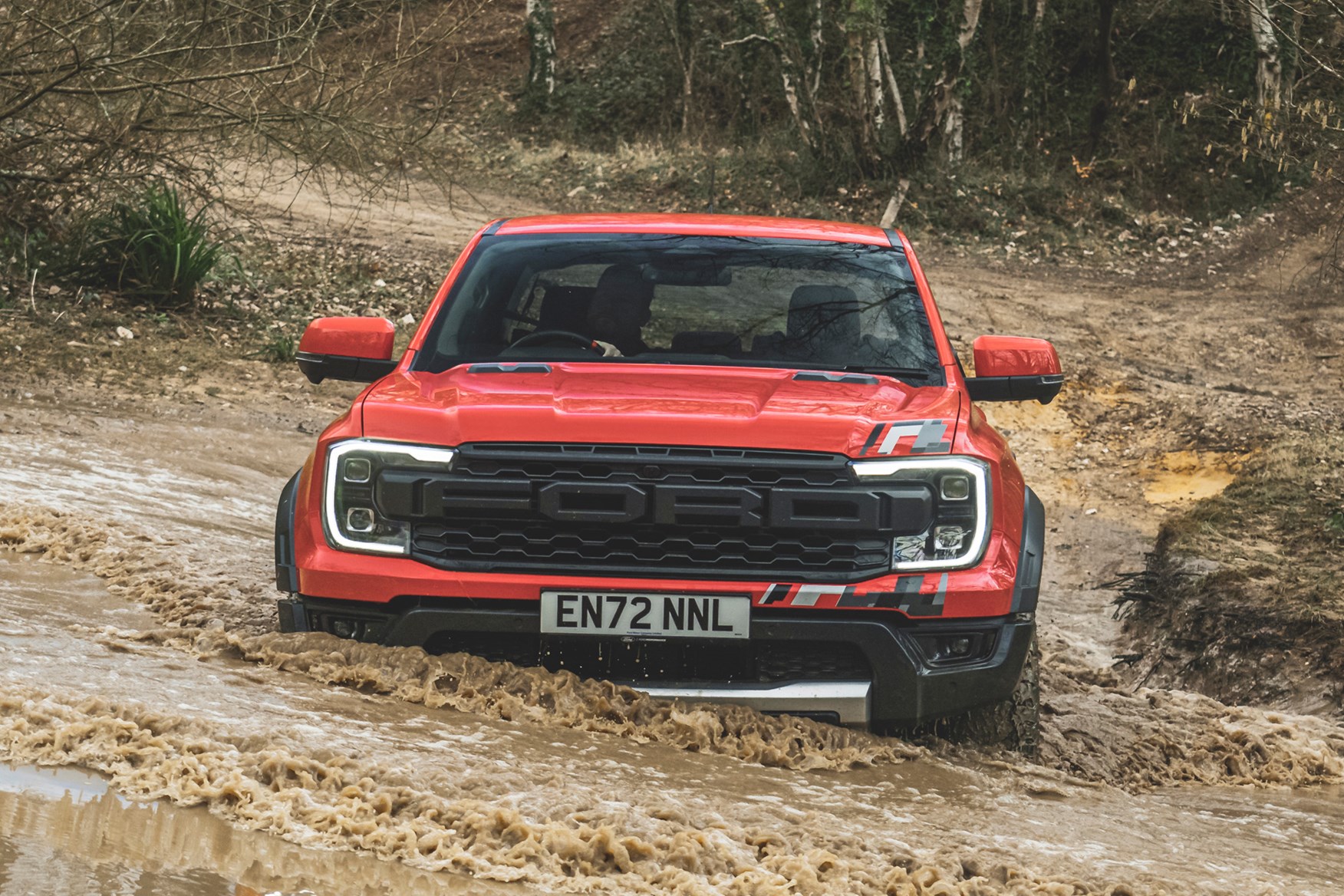
Its character means that you need to be careful when buying a used one, though. There’s every chance your purchase will have had a hard life off-road. If you think the seller isn’t being truthful about its history, check underneath for dents on the skid plates and make sure that it has met the servicing schedules.
- Clever front-mid airbag
- Plenty of standard driver assistance tech
- Five-star safety rating from Euro NCAP
The Ranger Raptor is a top-of-the-line model, which means it has loads of safety equipment as standard.
Ford Ranger Raptor safety
The Raptor features airbags for both front occupants, and an additional one that deploys between the front seats to prevent passengers from colliding in the event of an accident.
There is also a wide range of standard driver assistance systems, including the following:
- Blind-spot assist and information system, including trailer coverage
- Intelligent adaptive cruise control with stop and go and lane centring
- Lane-keeping assist
- Trailer reversing assistance
- 360-degree camera
- Trail control, which allows you to set a low speed while driving off road
- Tyre-pressure monitoring system
Which Ford Ranger Raptor is best for me?
You haven’t got a lot of choice. There’s only one trim-level and a handful of options to pick through, so it’s simply a case of choosing how you want your truck to look.
Sure, Ford gives you the choice of a petrol and a diesel engine, but we’d ignore the latter completely. It doesn’t make a huge difference to the Raptor’s fuel economy and you’ll sacrifice all the off-road equipment that makes the truck so appealing. If you want an all-out off-road toy, the V6 is by far the more tempting option.



